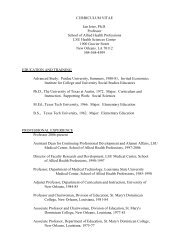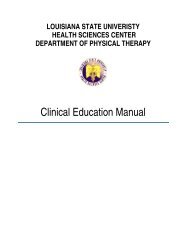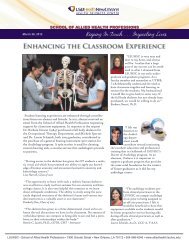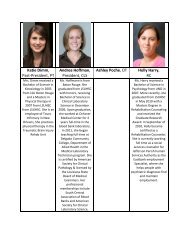CURRICULUM VITAE Noelle G. Moreau, PhD, PT Assistant ...
CURRICULUM VITAE Noelle G. Moreau, PhD, PT Assistant ...
CURRICULUM VITAE Noelle G. Moreau, PhD, PT Assistant ...
Create successful ePaper yourself
Turn your PDF publications into a flip-book with our unique Google optimized e-Paper software.
<strong>CURRICULUM</strong> <strong>VITAE</strong><strong>Noelle</strong> G. <strong>Moreau</strong>, <strong>PhD</strong>, <strong>PT</strong><strong>Assistant</strong> ProfessorDepartment of Physical TherapySchool of Allied Health ProfessionsLSU Health Sciences Center1900 Gravier St., 7 th FlNew Orleans, LA 70112(504) 568-4291Nmorea@lsuhsc.eduEducation and Training2008 Postdoc Washington University School of Medicine, St. Louis, MO, Department ofPhysical Therapy, Movement Science2007 <strong>PhD</strong> Louisiana State University, Baton Rouge, LA, Department of Kinesiology, MotorBehavior/Biomechanics1996 BS Louisiana State University Medical Center, Shreveport, LA, Physical TherapyProfessional Experience/Employment History2012 <strong>Assistant</strong> Professor, Louisiana State University Health Science Center,Department of Physical Therapy, New Orleans, LA.2008 <strong>Assistant</strong> Professor, Medical University of South Carolina, Department of HealthProfessions, Charleston, SC2007 Post-Doctoral Research Scholar, Washington University School of Medicine,Department of Physical Therapy, St. Louis, MO2002 Louisiana State Board of Regents Doctoral Fellow, Louisiana State University,Department of Kinesiology, Baton Rouge, LA2000-2006 Adjunct Faculty, Louisiana State University Health Science Center, Departmentof Physical Therapy, Shreveport and New Orleans, LA (2005-2006).2002-2004 Therapy Services Representative, Medtronic, Minneapolis, MN1998-2002 Lead Physical Therapist and Research Therapist, Shriners Hospital for Children,Shreveport, LA1996-1998 Physical Therapist, Tri-State Physical Therapy Rehab, Acute, and OutpatientServices, Shreveport, LACertification/Licensure2012 Louisiana Board of Physical Therapy Examiners. License #032572008 South Carolina Board of Physical Therapy Examiners. License #5851
1996 Louisiana Board of Physical Therapy Examiners. License #03257Professional Organization Memberships2012-present Louisiana Physical Therapy Association (L<strong>PT</strong>A)2008-2012 South Carolina Physical Therapy Association (SCA<strong>PT</strong>A)2007-present American Academy of Cerebral Palsy and Developmental Medicine (AACPDM)2004-present A<strong>PT</strong>A Section on Pediatrics1996-present American Physical Therapy Association (A<strong>PT</strong>A)1996-2008 Louisiana Physical Therapy Association (L<strong>PT</strong>A)1999-present Gait and Clinical Movement Analysis Society (GCMAS)PublicationsRefereed Journal ArticlesDew, A. P. & <strong>Moreau</strong>, N. G. (2012). A comparison of 2 techniques for measuring rectusfemoris muscle thickness in cerebral palsy. Pediatr.Phys.Ther., 24, 218-222.<strong>Moreau</strong>, N. G., Falvo, M. J., & Damiano, D. L. (2012). Rapid force generation is impaired incerebral palsy and is related to decreased muscle size and functional mobility. Gait Posture,35, 154-158.<strong>Moreau</strong>, N. G., Simpson, K. N., Teefey, S. A., & Damiano, D. L. (2010). Muscle architecturepredicts maximum strength and is related to activity levels in cerebral palsy. Phys.Ther., 90,1619-1630.<strong>Moreau</strong>, N. G., Li, L., Geaghan, J. P., & Damiano, D. L. (2009). Contributors to fatigueresistance of the hamstrings and quadriceps in cerebral palsy. Clin.Biomech.(Bristol., Avon.),24, 355-360.<strong>Moreau</strong>, N. G., Teefey, S. A., & Damiano, D. L. (2009). In vivo muscle architecture and sizeof the rectus femoris and vastus lateralis in children and adolescents with cerebral palsy.Dev.Med.Child Neurol., 51, 800-806.Damiano, D. L. & <strong>Moreau</strong>, N. (2008). Muscle thickness reflects activity in CP but how welldoes it represent strength? Dev.Med.Child Neurol., 50, 88.<strong>Moreau</strong>, N. G., Li, L., Geaghan, J. P., & Damiano, D. L. (2008). Fatigue resistance during avoluntary performance task is associated with lower levels of mobility in cerebral palsy.Arch.Phys.Med.Rehabil., 89, 2011-2016.<strong>Moreau</strong>, N., Li, L., & Damiano, D. L. (2008). A feasible and reliable muscle fatigueassessment protocol for individuals with cerebral palsy. Pediatr.Phys.Ther., 20, 59-65.
<strong>Moreau</strong>, N., Tinsley, S., & Li, L. (2005). Progression of knee joint kinematics in childrenwith cerebral palsy with and without rectus femoris transfers: a long-term follow up.Gait.Posture., 22, 132-137.Submitted for publication<strong>Moreau</strong> N.G., Holthaus K., Marlow N.M. (2012). Differential Adaptations of MuscleArchitecture in Response to High Velocity versus Traditional Strength Training in CerebralPalsy. Neurorehabilitation and Neural Repair.Martin A, Johnson L, Coker-Bolt P, <strong>Moreau</strong> NG, Perkel J, Jenkins D. (2012). A caseexploration of early motor delays and early intervention for an extremely premature infant.Physical and Occupational Therapy in Pediatrics.Coker-Bolt P, Woodbury M, Perkel J, <strong>Moreau</strong> NG, Jenkins D. (2012). Early motor skilldifferences in low and high risk premature infants. Dev Med Child Neurology.Refereed Abstracts<strong>Moreau</strong> NG, Holthaus K, Marlow NM. (2012). Muscle Architectural Plasticity of theQuadriceps in Response to High Velocity vs. Traditional Strength Training in Cerebral Palsy:a Randomized Clinical Trial. Pediatric Physical Therapy, 24(1):91<strong>Moreau</strong> NG, Holthaus K, Marlow NM. (2012). Muscle Architectural Plasticity of theQuadriceps in Response to High Velocity vs. Traditional Strength Training in Cerebral Palsy:Effects on Function, Self-Concept, Activity and Participation. Pediatric Physical Therapy,24(1):92<strong>Moreau</strong> NG, Holthaus K, Marlow NM. (2011). Differential Adaptations of MuscleArchitecture in Response to High Velocity versus Traditional Strength Training in CerebralPalsy. Developmental Medicine and Child Neurology, 53(s5), 15 ; Gayle G. Arnold AwardNominee for Best Free Paper<strong>Moreau</strong> NG, Holthaus K. (2011). Motor Severity Negatively Affects Muscle Architecture inCP: a comparison between GMFCS levels, hemiplegia, and typically developing children.Developmental Medicine and Child Neurology, 53(s5), 78<strong>Moreau</strong> NG, Falvo M., Damiano DL. (2011). Rapid force generation of the knee extensors ismore impaired than strength in cerebral palsy and is related to decreased muscle size andfunctional mobility. Gait & Posture, supplementDew AP, <strong>Moreau</strong> NG. (2011). Getting the most out of a 2D ultrasound measure of musclethickness in children with cerebral palsy. Gait & Posture, supplement
<strong>Moreau</strong> NG, Knight H, Olson MW. (2011). To decline or not to decline: a potentialmechanism by which torque output is preserved in cerebral palsy. Pediatric PhysicalTherapy, 23(1), 101<strong>Moreau</strong> NG, Teefey S, Damiano DL. (2010). Decreased ability to produce torque per unit ofcross-sectional area of the rectus femoris is related to standing and walking performance incerebral palsy. Pediatric Physical Therapy, 22(1), 99-100<strong>Moreau</strong> NG, Stanley C, Miros J, Scholtes S, Teefey S, Brunstrom-Hernandez, J, DamianoDL. (2009). Muscle plasticity in children with cerebral palsy in response to intensive activity:a pilot study. Developmental Medicine and Child Neurology, 51(s5), 17<strong>Moreau</strong> NG, Stanley C, Teefey S, Damiano DL. (2009). Muscle architecture of thequadriceps is related to strength and function in children with cerebral palsy. PediatricPhysical Therapy, 21(1), 94<strong>Moreau</strong> NG, Stanley C, Teefey S, Damiano DL. (2008). In vivo muscle architecture of therectus femoris and vastus lateralis in cerebral palsy. Developmental Medicine and ChildNeurology, 50(s4), 30-31<strong>Moreau</strong> NG, Stanley C, Teefey S, Damiano DL. (2008). Relationship of muscle architectureof the quadriceps with strength and function in children with cerebral palsy. DevelopmentalMedicine and Child Neurology, 50(s4), 59<strong>Moreau</strong> NG, Li L, Damiano DL. (2008). Contributors to fatigue resistance of the hamstringsand quadriceps in cerebral palsy. Pediatric Physical Therapy, 20(1), 96-97<strong>Moreau</strong> NG, Li L, Damiano DL. (2007). Absolute torque level contributes to fatigueresistance of the hamstrings and quadriceps in cerebral palsy. Developmental Medicine andChild Neurology, 49(s11), 28<strong>Moreau</strong> NG, Li L, Damiano DL. (2006). Are muscle strength and fatigue related to walkingvelocity in individuals with and without cerebral palsy? Gait & Posture, 24 (Supp. 2), S257-S258<strong>Moreau</strong> NG, Li L, Damiano DL. (2006). Development of a feasible and reliable musclefatigue protocol for individuals with cerebral palsy. Developmental Medicine and ChildNeurology, 48(s106), 39-40<strong>Moreau</strong> NG, Li L, Damiano DL. (2006). Is fatigue a problem at the muscle level in cerebralpalsy? Developmental Medicine and Child Neurology, 48(s106), 5<strong>Moreau</strong> N, Tinsley S, Li L. (2004). Progression of knee joint kinematics in children withcerebral palsy with and without rectus femoris transfers: a long-term follow up. Gait &Posture, 20(Supp. 1), S16
<strong>Moreau</strong> N, Tinsley S, Cavell A, Semones K. (2004). Long Term Outcomes of RectusFemoris Transfers in Children with Cerebral Palsy. Pediatric Physical Therapy, 16(1), 62<strong>Moreau</strong> N, Simpson J, Wilkerson J, Gates P. (2003). Goal Specific Outcomes of RectusFemoris Transfers in Children with Cerebral Palsy Based on Stance-Phase Characteristics.Pediatric Physical Therapy, 15(1), 51-71<strong>Moreau</strong> N, Simpson J, Wilkerson J, Gates P. (2002). Goal Specific Outcomes of RectusFemoris Transfers in Children with Cerebral Palsy Based on Stance-Phase Characteristics.Developmental Medicine and Child Neurology, 44(8), 17Tinsley SL, <strong>Moreau</strong> N, and Fabre J. The Effects of Rectus Femoris Transfer Surgery on Gaitin Children with Cerebral Palsy. (2002). Pediatric Physical Therapy, 13(4), 205Tinsley, S.L., <strong>Moreau</strong>, N., Pennywell, S., Judd, D., Dugas, B., Fabre, J. (2002). The effect ofrectus femoris transfer and hamstring lengthening on gait in children with cerebral palsy.Pediatric Physical Therapy, 13(4), 206<strong>Moreau</strong> N, Tinsley SL, Judd D, Dugas B, Fabre J, Pennywell S, Gates P. (2001). StancePhase Characteristics as a Predictor for Rectus Femoris Transfers. Gait & Posture, 13, 252Other Scholarly/Creative/Artistic ContributionsN/AProfessional PresentationsInvited lecturesEarly Identification of the Child at High Risk for Neurodevelopmental Delay11th Annual Pediatric Neuroscience Update sponsored by the Department ofNeurosciences at the Medical University of South Carolina, Kiawah Island, SC, March23-24, 2012Life after the NICU: How to tell if your baby is okayPediatric Grand Rounds sponsored by the Department of Pediatrics at the MedicalUniversity of South Carolina, Charleston, SC, April 21, 2011Muscle Architectural Plasticity in Cerebral Palsy: a Research Update9 th Annual Pediatric Neuroscience Update sponsored by the Department ofNeurosciences at the Medical University of South Carolina, Charleston, SC, April 9-10,2010
Muscle Architectural Plasticity in Cerebral Palsy: Challenging Existing ParadigmsScientific Retreat on Bioengineering and Regenerative Medicine sponsored by the SouthCarolina Clinical and Translational Research Institute & South Carolina BioengineeringAlliance, Charleston, SC, March 24, 2010Muscle Architectural Plasticity in Children and Adolescents with Cerebral Palsy, Universityof South Carolina Arnold School of Public Health Research Seminar, March 2009Ultrasound Imaging of Quadriceps Muscle Architecture in Children with Cerebral Palsy,Washington University Program in Physical Therapy Research Program Seminar,February 2008Pathological Gait in Cerebral Palsy, Pediatric Orthopedic Conference / Shriners Hospital,Shrevport, LA, May 25, 1999; 2001Normal Gait and Gait Lab Basics, Pediatric Orthopedic Conference / Shriners Hospital,Shreveport, LA, May 5, 1999Gait Analysis Laboratory Basics, Department of Physical Therapy, LSU Medical University,Shreveport, LA, Spring 1999-2001Therapeutic Use of Modalities, Occupational Therapy <strong>Assistant</strong> Program,Panola Junior College, Fall 1998Oral/platform presentations at professional meetings<strong>Moreau</strong> NG, Holthaus K, Marlow NM. “Muscle Architectural Plasticity of the Quadriceps inResponse to High Velocity vs. Traditional Strength Training in Cerebral Palsy: aRandomized Clinical Trial” Section on Pediatrics, Combined Sections meeting, A<strong>PT</strong>A,Chicago, IL February 8-11, 2012.<strong>Moreau</strong> NG, Holthaus K, Marlow NM. “Muscle Architectural Plasticity of the Quadriceps inResponse to High Velocity vs. Traditional Strength Training in Cerebral Palsy: Effects onFunction, Self-Concept, Activity and Participation” Section on Pediatrics, CombinedSections meeting, A<strong>PT</strong>A, Chicago, IL February 8-11, 2012.<strong>Moreau</strong> NG, Holthaus K, Marlow NM. “Differential Adaptations of Muscle Architecture inResponse to High Velocity versus Traditional Strength Training in Cerebral Palsy” AmericanAcademy for Cerebral Palsy and Developmental Medicine, Las Vegas, NV October 12-15,2011 ; Gayle G. Arnold Award Nominee for Best Free Paper<strong>Moreau</strong> NG, Knight H, Olson MW. “To decline or not to decline: a potential mechanism bywhich torque output is preserved in cerebral palsy.” Section on Pediatrics, CombinedSections meeting, A<strong>PT</strong>A, New Orleans, LA February 9-12, 2011.
<strong>Moreau</strong> NG, Teefey S, Damiano DL. “Decreased ability to produce torque per unit of crosssectionalarea of the rectus femoris is related to standing and walking performance in cerebralpalsy.” Section on Pediatrics, Combined Sections meeting, A<strong>PT</strong>A, San Diego, CA, February17-20, 2010.<strong>Moreau</strong> NG, Stanley C, Miros J, Scholtes S, Teefey S, Brunstrom-Hernandez, J, DamianoDL. “Muscle plasticity in children with cerebral palsy in response to intensive activity: apilot study.” American Academy for Cerebral Palsy and Developmental Medicine,Scottsdale, AZ, September 23-26, 2009.<strong>Moreau</strong> NG, Stanley C, Teefey S, Damiano DL. “Muscle architecture of the quadriceps isrelated to strength and function in children with cerebral palsy.” Section on Pediatrics,Combined Sections meeting, A<strong>PT</strong>A, Las Vegas, NV, February 10, 2009.<strong>Moreau</strong> NG, Teefey S, Damiano DL. “Muscle architectural plasticity in children withcerebral palsy: a pilot study.” Neurobiology of Disease in Children New InvestigatorSymposium, Child Neurology Society 37 th Annual Meeting, Santa Clara, CA, November 6,2008<strong>Moreau</strong> NG, Stanley C, Teefey S, Damiano DL. “In vivo muscle architecture of the rectusfemoris and vastus lateralis in cerebral palsy.” American Academy for Cerebral Palsy andDevelopmental Medicine, Atlanta, GA, September 2008, ; Gayle G. Arnold Award Nomineefor Best Free Paper<strong>Moreau</strong> NG, Stanley C, Teefey S, Damiano DL. “Rectus femoris fascicle length is related todynamic measures of knee excursion during gait in cerebral palsy.” Gait and ClinicalMovement Analysis Society Annual meeting, April 2-5, 2008, Richmond, VA.<strong>Moreau</strong> NG, Li L, Damiano DL. “Contibutors to fatigue resistance of the hamstrings andquadriceps in cerebral palsy.” Section on Pediatrics, Combined Sections meeting, A<strong>PT</strong>A,Nashville, TN, 2008.<strong>Moreau</strong> NG, Li L, Damiano DL. “Absolute torque level contributes to fatigue resistance ofthe hamstrings and quadriceps in cerebral palsy.” American Academy for Cerebral Palsy andDevelopmental Medicine, October 10-14, 2007, Vancouver BC.<strong>Moreau</strong> NG, Li L, Damiano DL. “Development of a feasible and reliable muscle fatigueprotocol for individuals with cerebral palsy.” American Academy for Cerebral Palsy andDevelopmental Medicine, Boston, MA, 2006.<strong>Moreau</strong> NG, Li L, Damiano DL. “Is fatigue a problem at the muscle level in cerebral palsy?”American Academy for Cerebral Palsy and Developmental Medicine, Boston, MA, 2006.<strong>Moreau</strong> N, Tinsley S, Li L. “Progression of knee joint kinematics in children with cerebralpalsy with and without rectus femoris transfers: a long-term follow up”. 9 th Annual Meetingof the Gait and Clinical Movement Analysis Society, Lexington, KY, 2004.
<strong>Moreau</strong> N, Tinsley S, Cavell A, Semones K. “Long Term Outcomes of Rectus FemorisTransfers in Children with Cerebral Palsy”. Section on Pediatrics, Combined Sectionsmeeting, A<strong>PT</strong>A, Nashville, TN, 2004.<strong>Moreau</strong> N, Tinsley S, Cavell A, Semones K. “Long Term Outcomes of Rectus FemorisTransfers in Children with Cerebral Palsy”. Louisiana State Physical Therapy AssociationFall Conference, New Orleans, LA. September 6, 2003.<strong>Moreau</strong> N, Simpson J, Wilkerson J, Gates P. “Goal Specific Outcomes of Rectus FemorisTransfers in Children with Cerebral Palsy Based on Stance-Phase Characteristics”. Sectionon Pediatrics, Combined Sections Meeting, A<strong>PT</strong>A, Tampa, FL, 2003.<strong>Moreau</strong> N, Simpson J, Wilkerson J, Gates P. “Goal Specific Outcomes of Rectus FemorisTransfers in Children with Cerebral Palsy Based on Stance-Phase Characteristics”. 56 thAnnual Meeting of the American Academy for Cerebral Palsy and Developmental Medicine,New Orleans, LA, 2002.<strong>Moreau</strong> N, Simpson J, Wilkerson J, Gates P. “Goal Specific Outcomes of Rectus FemorisTransfers in Children with Cerebral Palsy Based on Stance-Phase Characteristics”. LouisianaState Physical Therapy Association Fall Conference, New Orleans, LA. September 6, 200.2<strong>Moreau</strong> N, Tinsley SL, and Dugas B. “Stance Phase Characteristics as a Predictor for RectusFemoris Transfers”, Louisiana State Physical Therapy Association Fall Conference, NewOrleans, LA. September 7, 2001; -Best Platform Presentation AwardPoster presentations at professional meetingsCoker-Bolt P, <strong>Moreau</strong> N, Perkel J, Mulvihill D, Woodbury M, Jenkins D. Very early,quantifiable motor skills in preterm infants. Pediatric Academic Societies Annual Meeting,Boston, MA April 28 – May 1, 2012.<strong>Moreau</strong> NG, Holthaus K. “Motor Severity Negatively Affects Muscle Architecture in CP: acomparison between GMFCS levels, hemiplegia, and typically developing children”American Academy for Cerebral Palsy and Developmental Medicine, Las Vegas, NVOctober 12-15, 2011.<strong>Moreau</strong> NG., Falvo M., Damiano DL. “Rapid force generation of the knee extensors is moreimpaired than strength in cerebral palsy and is related to decreased muscle size andfunctional mobility” Gait and Clinical Movement Analysis Society Annual meeting, April26-29, 2011, Bethesda, MD.Dew AD, <strong>Moreau</strong> NG. “Getting the most out of a 2D ultrasound measure of muscle thicknessin children with cerebral palsy.” Gait and Clinical Movement Analysis Society Annualmeeting, April 26-29, 2011, Bethesda, MD.
<strong>Moreau</strong> NG, Stanley C, Teefey S, Damiano DL. “Relationship of muscle architecture of thequadriceps with strength and function in children with cerebral palsy.” Darby ResearchChildren’s Institute 4 th Annual Meeting, Charleston, SC, February 12, 2009.<strong>Moreau</strong> NG, Stanley C, Teefey S, Damiano DL. “Relationship of muscle architecture of thequadriceps with strength and function in children with cerebral palsy.” American Academyfor Cerebral Palsy and Developmental Medicine, Atlanta, GA, September 2008.<strong>Moreau</strong> NG, Li L, Damiano DL. “Are muscle strength and fatigue related to walkingvelocity in individuals with and without cerebral palsy?” Combined Gait & ClinicalMovement Analysis Society/European Society of Movement Analysis for Adults andChildren Meeting, September 27-30, 2006, Amsterdam, The Netherlands.Gates P, <strong>Moreau</strong> N, Bicknell S, Ostendorff S. “Modified ERTL procedure for TerminalOvergrowth in Childhood Below-knee Limb Deficiencies: Comparison with Excision andPeriosteal Closure.” Association of Children’s Prosthetic-Orthotic Clinics Annual Meeting,Toronto, Canada, 2002.Tinsley SL, <strong>Moreau</strong> N, and Fabre J. “The Effects of Rectus Femoris Transfer Surgery onGait in Children with Cerebral Palsy.” Section on Pediatrics, Combined Sections Meeting,A<strong>PT</strong>A, Boston MA, 2002.Tinsley, S.L., <strong>Moreau</strong>, N., Pennywell, S., Judd, D., Dugas, B., Fabre, J. “The effect of rectusfemoris transfer and hamstring lengthening on gait in children with cerebral palsy”. Sectionon Pediatrics, Combined Sections Meeting, A<strong>PT</strong>A, Boston MA, 2002.<strong>Moreau</strong> N, Tinsley SL, Judd D, Dugas B, Fabre J, Pennywell S, Gates P. “Stance PhaseCharacteristics as a Predictor for Rectus Femoris Transfers”. 6 th Annual Meeting of the Gaitand Clinical Movement Analysis Society, Sacramento, CA, 2001.<strong>Moreau</strong> N, Tinsley SL, and Fabre J. “The Effects of Rectus Femoris Transfer Surgery onGait in Children with Cerebral Palsy.” Louisiana State Physical Therapy Association FallConference, New Orleans, LA. September 7, 2001.Other professional presentationsJudd C, Smart-Balleh M, Holthaus K, Perkel J, Coker-Bolt P, Jenkins D, <strong>Moreau</strong> NG.“Reliability of Lower Extremity Kinematics Obtained Using Two-Dimensional VideoAnalysis in Young Infants.” Annual Perry V. Halushka MUSC Student Research Day,November 4, 2011.Smart-Balleh, M; Judd C, Holthaus K, Perkel J, Coker-Bolt P, Jenkins D, <strong>Moreau</strong> NG.“Differences in Muscle Architecture, Passive and Dynamic Range of Motion in High andLow Risk Preterm Infants.” Annual Perry V. Halushka MUSC Student Research Day,November 4, 2011.
Dew AD, <strong>Moreau</strong> NG. “Getting the most out of a 2D ultrasound measure of muscle thicknessin children with cerebral palsy.” Annual Perry V. Halushka MUSC Student Research Day,November 5, 2010.Vanderwerker C, Holthaus K, <strong>Moreau</strong> NG. “Muscle Plasticity of the Quadriceps in Responseto Velocity-Enhanced Resistance Training in a Teenager with Cerebral Palsy ImprovesMuscle Performance and Quality of Life: a Case Report.” Annual Perry V. Halushka MUSCStudent Research Day, November 6, 2009.Awards, Prizes, Lectureships2011 Gayle G. Arnold Award Nominee for Best Free Paper, American Academy ofCerebral Palsy and Developmental Medicine2008 Neurobiology of Disease in Children (NDC) Young Investigator Award2008 Gayle G. Arnold Award Nominee for Best Free Paper, American Academy ofCerebral Palsy and Developmental Medicine2007 Louisiana State University Dissertation Fellowship Recipient2007 Louisiana State University Distinguished Dissertation Award Nominee2003 – 2006 Lilian Oleson Scholar, Louisiana State University, College of Education2002 – 2006 Louisiana State Board of Regents Fellowship Recipient, Louisiana StateUniversity, College of Education2002 – 2003 Mary McMillan Scholar, American Physical Therapy Association1996 Chancellor’s Award for Outstanding Student,Louisiana State University Medical Center, Shreveport, LA1996 Summa Cum Laude, Louisiana State University Medical Center, Shreveport, LAContributions to Juried or Refereed PublicationsJournal Editorial BoardJournal of Novel PhysiotherapiesManuscript ReviewerArchives of Physical Medicine and RehabilitationDevelopmental Medicine and Child NeurologyPediatric Physical Therapy
Gait & PostureJournal of BiomechanicsPediatricsJournal of Pediatric BiochemistryGrants and Contracts FundedSubmitted:R01 Jenkins (PI) Submitted July, 2012NICHD / NIHQuantitative Developmental Assessments of Infants at risk for Intellectual and DevelopmentalDisabilities (IDD)Amount: $1,000,000Role: Co-I (15% effort)Mentored Scientist Career Development Award (K01) <strong>Moreau</strong> (PI) Submitted March, 2012NICHD / NIHNeural Mechanisms of Impaired lnterlimb Coordination in Hemiplegic Cerebral PalsyAmount: $628,193Role: PI (75% effort)Current Support:Beginning Grant-in-Aid Gregory (PI) 7/01/11 – 6/30/13American Heart AssociationLower Extremity Power and Locomotor Function after StrokeGoal: The primary objective is to establish a scientific framework to maximize walkingAmount: $153,975Role: Co-I (10% effort)Pilot Project Coker (PI) 7/01/10 – 06/30/12MUSC SCOR (Specialized Center of Research) on Sex and Gender Factors Affecting Women'sHealthEarly Gender Related Motor Skills Differences in Female and Male Preterm InfantsAmount: $20,000Role: Co-IPrevious Support:Pedal-with-Pete Foundation <strong>Moreau</strong>, PI 1/01/09-06/31/11In Vivo Assessment of Quadriceps Muscle Plasticity in Children with Cerebral PalsyAmount: $38,000Role: PI
New Investigator Award <strong>Moreau</strong> (PI) 1/01/09-12/31/10Thrasher Research FundIn Vivo Assessment of Quadriceps Muscle Plasticity in Children with Cerebral PalsyRole: PIClinical Research Grant <strong>Moreau</strong> (PI) 6/01/07-05/31/09Section on Pediatrics, American Physical Therapy AssociationPhysical Activity and Muscle Plasticity in Cerebral PalsyRole: PIT32-HD007434-13 Miller (PI) 01/2007 – 08/2008NIH/NCMRRMovement Science Program, Dept. of Physical Therapy, Washington University in St. LouisRole: Postdoctoral Research FellowClinical Research Grant <strong>Moreau</strong> (PI) 6/01/05-05/31/06Section on Pediatrics, American Physical Therapy AssociationQuantification of Muscle Fatigue in Cerebral PalsyRole: PIDissertation Year Fellowship 8/15/07-05/31/08Louisiana State University Graduate SchoolDissertation title: Quantification of Muscle Fatigue in Cerebral Palsy and Its Relationship toImpairments and FunctionMary McMillan Doctoral Scholarship 9/01/02-8/31/03Foundation for Physical TherapyMajor Areas of Research InterestUse of ultrasound imaging in the investigation of muscle architectural plasticity in responseto interventions in cerebral palsyDevelopment of effective rehabilitation strategies to enhance muscle function and quality oflife in people with cerebral palsyMechanisms underlying abnormal force production in youth with cerebral palsy and othermovement disorders, such as stroke3D Gait analysis of abnormal movement patterns in movement disordersTeaching ExperienceCourses taught current year (to be taught in 2012-2013)PHTH 7101 Evidence-Based <strong>PT</strong> I: Clinical Analyses, Doctor of Physical Therapy Program,LSUHSC (Lecturer).
PHTH 7102 Evidence-Based <strong>PT</strong> II: Clinical Analyses, Doctor of Physical Therapy Program,LSUHSC (Lecturer).PHTH 7240 Motor Behavior, Doctor of Physical Therapy Program, LSUHSC.(Instructor)PHTH 7132 Movement Sciences II, Doctor of Physical Therapy Program, LSUHSC.(Course Coordinator)PHTH 7271 Diagnosis & Management in Neuromuscular Disorders, Doctor of Physical TherapyProgram, LSUHSC (Lecturer)Courses taught prior year (2011 – 2012)Biomechanical Analysis of Human Movement, Doctor of Physical Therapy Program, Division ofPhysical Therapy, Medical University of South Carolina (Course Director)Research Seminar, Doctor of Physical Therapy Program, Division of Physical Therapy, MedicalUniversity of South Carolina (Instructor)Research Project Elective, Doctor of Physical Therapy Program, Division of Physical Therapy,Medical University of South Carolina (Instructor)Motor Development, Doctor of Physical Therapy Program, Division of Physical Therapy,Medical University of South Carolina (Course coordinator)Lab Rotation, <strong>PhD</strong> Program in Health and Rehabilitation Sciences, Department of HealthSciences and Research, Medical University of South Carolina (Instructor)Independent Study, <strong>PhD</strong> Program in Health and Rehabilitation Sciences, Department of HealthSciences and Research, Medical University of South Carolina (Instructor)Directed student research projectsJudd, Caitlin. Reliability of Lower Extremity Kinematics Obtained Using Two-DimensionalVideo Analysis in Young Infants. Doctor of Physical Therapy Program, Department of HealthProfessions, Medical University of South Carolina. 2011.Smart-Balleh, Margaret. Differences in Muscle Architecture, Passive and Dynamic Range ofMotion in High and Low Risk Preterm Infants. Doctor of Physical Therapy Program, Departmentof Health Professions, Medical University of South Carolina. 2011.Dew, AP. Getting the most out of a 2D ultrasound measure of muscle thickness in children withcerebral palsy. Doctor of Physical Therapy Program, Department of Health Professions, MedicalUniversity of South Carolina. 2010.
Vanderwerker, Catherine. Muscle Plasticity of the Quadriceps in Response to Velocity-EnhancedResistance Training in a Teenager with Cerebral Palsy Improves Muscle Performance andQuality of Life: a Case Report. Doctor of Physical Therapy Program, Department of HealthProfessions, Medical University of South Carolina. 2009.Pennywell, S., Judd, D., Dugas, B., Fabre, J. The effect of rectus femoris transfer and hamstringlengthening on gait in children with cerebral palsy. Master of Physical Therapy Program,Department of Physical Therapy, LSUHSC-S, 2001.Fabre, J., Pennywell, S., Judd, D., Dugas, B. The effect of rectus femoris transfer surgery on gaitin children with cerebral palsy. Master of Physical Therapy Program, Department of PhysicalTherapy, LSUHSC-S, 2001.Simpson J., Wilkerson J. Goal Specific Outcomes of Rectus Femoris Transfers in Children withCerebral Palsy Based on Stance-Phase Characteristics. Master of Physical Therapy Program,Department of Physical Therapy, LSUHSC-S, 2002.Cavell A, Semones K. Long Term Outcomes of Rectus Femoris Transfers in Children withCerebral Palsy. Master of Physical Therapy Program, Department of Physical Therapy,LSUHSC-S, 2003.Professional Organization Service2010-present Chair of the Awards Committee - Section on Pediatrics, American PhysicalTherapy Association2010-present Awards Committee – American Academy of Cerebral Palsy and DevelopmentalMedicine2009-present Research Committee MemberSection on Pediatrics, American Physical Therapy Association2009-present Combined Sections Meeting Abstract Reviewer, Section on Pediatrics2007-present Gait and Clinical Movement Analysis Society Abstract Reviewer2001-20002 Steering Task ForceShriners Hospital Motion Analysis Laboratory NetworkAcademic ServiceUniversity2011-2012 Faculty Senate - Medical University of South CarolinaSchool / College2010-2012 Promotion &Tenure Policy Writing Committee - Medical University of SouthCarolina College of Health Professions2010-2012 Research Resource Group - Medical University of South Carolina College ofHealth Sciences and Research
2010-2012 Search Committee Member – Faculty Position in the Department of HealthSciences and Research2009-2012 <strong>PhD</strong> Advisory Board – Medical University of South Carolina College of HealthProfessions2009-2012 <strong>PhD</strong> Curriculum Committee – Medical University of South Carolina College ofHealth Professions2009-2012 Research Council Member – Medical University of South Carolina College ofHealth Professions2009-2010 Search Committee Member – Division Director of Physical Therapy, MedicalUniversity of South Carolina, College of Health Professions2009-2010 Search Committee Member –Chair of the Department of Health Sciences andResearch, Medical University of South Carolina College of Health Professions2008-2012 CA<strong>PT</strong>E Accreditation Technology Committee Member – Medical University ofSouth Carolina College of Health Professions, Division of Physical TherapyPublic Service2009-2012 Volunteer - Anchors Aweigh Adaptive Ski Clinic, Charleston, SC2008-2012 Volunteer - Charleston and Summerville Miracle League, Charleston, SC2005 Volunteer – Hurricane Katrina Medical Triage Unit, Baton Rouge, LARevised 7/2012







